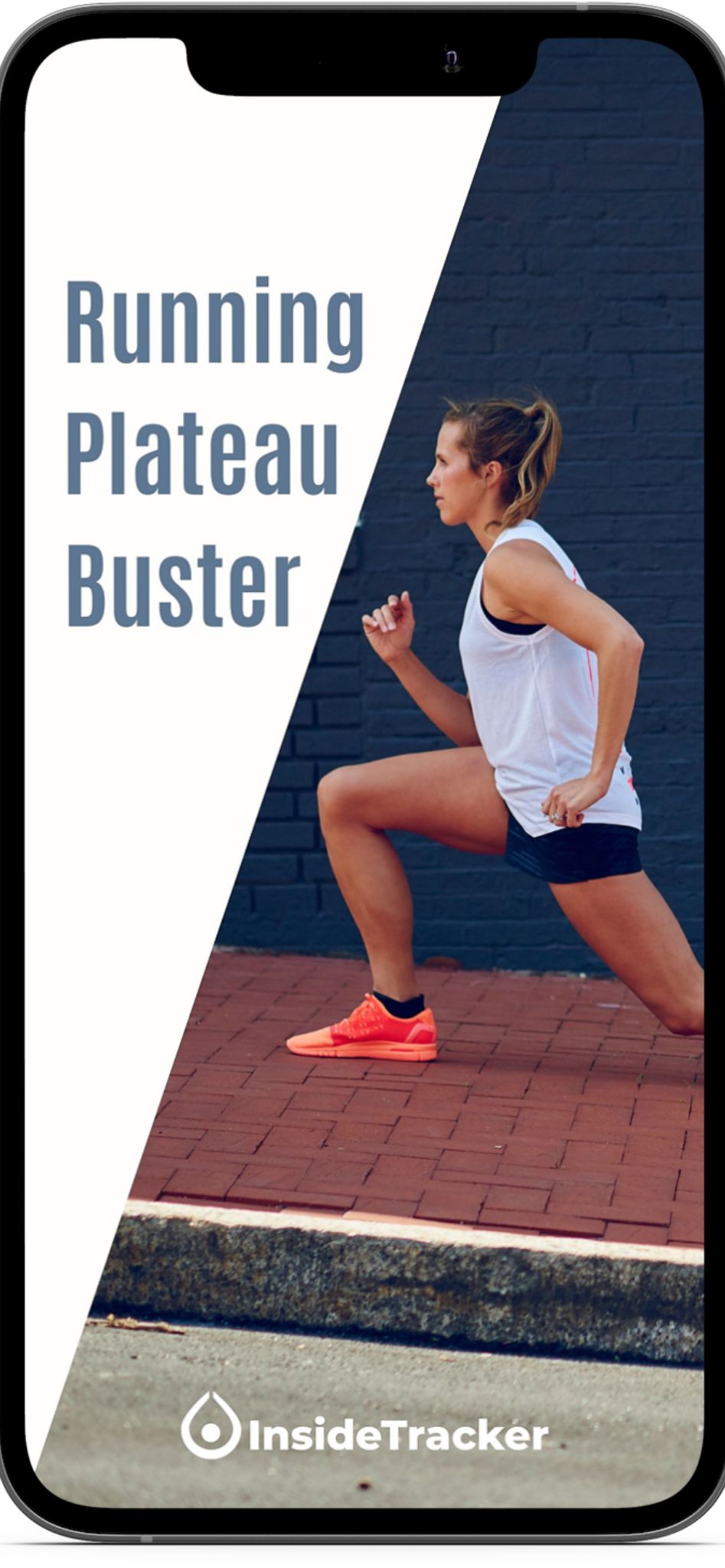Everything you need to crew confidently—from base camp to the backcountry.
Crewing an ultramarathon is part problem-solving, part emotional support, and a lot of waiting around in unpredictable conditions. While your main job is to keep your runner fed, fueled, and moving, having the right gear can make the experience smoother for both of you.
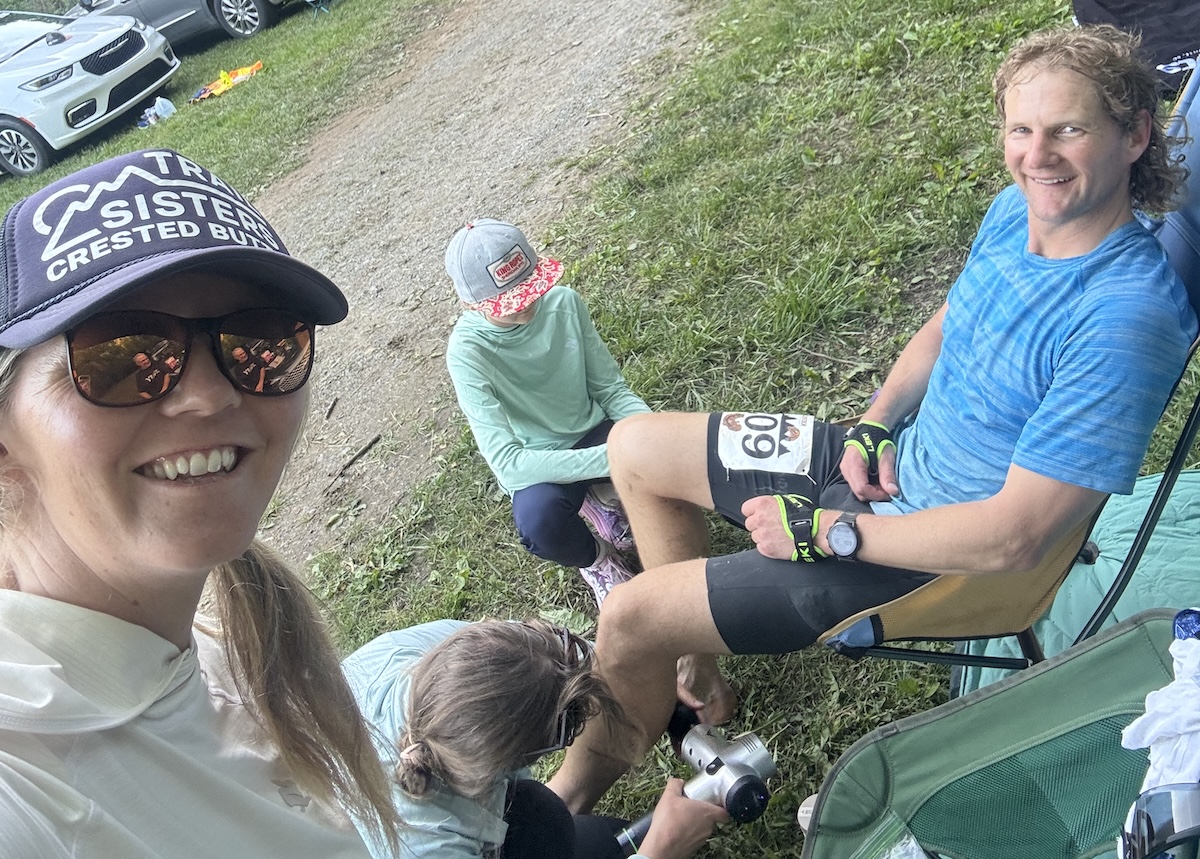 Yes, you could show up with just water, nutrition, and good vibes. But if your runner is tackling a 100-miler or a multi-loop suffer-fest through wild terrain, being well-equipped can mean the difference between chaos and calm.
Yes, you could show up with just water, nutrition, and good vibes. But if your runner is tackling a 100-miler or a multi-loop suffer-fest through wild terrain, being well-equipped can mean the difference between chaos and calm.
After crewing my husband, John, through three 100-mile races—most recently the Hellbender 100 this spring—plus countless other ultra distances, I’ve learned this: crewing is a lot like running an experiment. You prepare for every variable, then adapt when things change.
Start With the Rules and Conditions
Before you even pull out your gear bins, look at the race regs, profile, and forecast.
Some races have a recommended list, and others have mandatory gear. Be sure your runner has all the mandatory gear and backups!
 Are you crewing in the mountains or the desert? Will temps swing from 80°F during the day to freezing at night? Are you hiking into remote aid stations or staying put at a central crew spot?
Are you crewing in the mountains or the desert? Will temps swing from 80°F during the day to freezing at night? Are you hiking into remote aid stations or staying put at a central crew spot?
Gear needs vary significantly based on terrain, elevation, weather, and the accessibility of the course.
In hot races, you’ll need cooling tools like ice bandanas, sun sleeves, and electrolyte-heavy fuel. In cold races, you’ll want layers, insulated bottles, and backup hand warmers. And for mountainous ultras, always prep for four seasons in one day.
Depending on whether I’m flying or driving to the race, I pack everything in duffels or clear bins to keep gear organized and easy to access. Driving is ideal—I can bring everything I might need (and yes, sometimes even the kitchen sink). But when I’m flying, I have to pare things down to the essentials and pack more strategically. Be sure to plan ahead when you are packing!
Base Camp Setup
You’ll be outside for hours—sometimes 12, 24, even 36+. A comfortable setup makes a huge difference in how functional and focused you stay.
Bring a lightweight, packable camp chair for waiting and recovery zones. I like to throw in a collapsible stool for foot care and shoe changes. My favorite chair is the Helinox Chair One (re) and Speed Stool. Both are super light and easy to set up at aid stations. 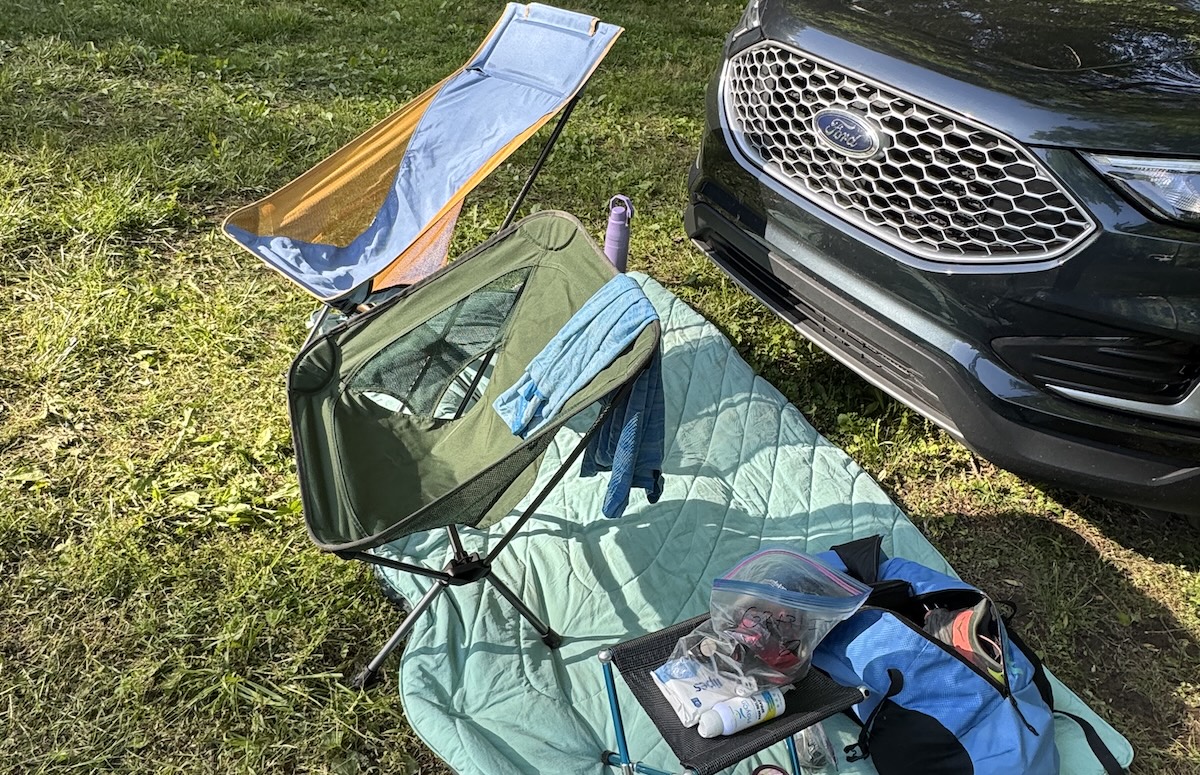 The Helinox Chair One (re) is definitely on the pricier side, but I think it’s worth the investment if you’re spending long days crewing ultras. I’ve tried cheaper alternatives, and more than once they’ve broken during setup or ended up with bent poles that never quite work the same again.
The Helinox Chair One (re) is definitely on the pricier side, but I think it’s worth the investment if you’re spending long days crewing ultras. I’ve tried cheaper alternatives, and more than once they’ve broken during setup or ended up with bent poles that never quite work the same again.
The Helinox Chair One (re) is sturdy, lightweight, packs down small, and sets up quickly—making it easy to bring along to aid stations, even the ones you have to hike into.
Like most of this gear, it has versatility beyond race day. The Helinox chair and stool works just as well for camping trips, campfire hangs, weekend sports sidelines, or anywhere I need to bring a chair. The size, durability, and ease of use make it a long-term piece of gear I keep reaching for, race season or not.
A warm blanket and a ground mat go a long way in creating a cozy, functional space, especially at overnight aid stations. I love using Rumpl travel blankets—they have snaps that turn them into a cape, which is perfect for keeping the crew warm while waiting or wrapping around a runner who needs to recharge.
The Overland Mat helps keep your area clean and dry, no matter the weather. It also acts as a visual anchor for your runner—something familiar and easy to spot in a busy aid station.
For hot races, I like to bring a larger cooler paired with a backpack cooler, if possible. The big cooler stays at basecamp or drive-up aid stations and holds ice, drinks, and meals. For hike-in locations, the REI Trail Split Pack Cooler is ideal—it keeps food and drinks cold while offering ample storage space for extra gear, such as layers, headlamps, or first aid supplies.
For remote or hike-in stations where I’m not carrying cold items, I’ll switch to a lightweight backpack, like one from Gossamer Gear.  Gossamer Gear packs are my favorite packs for crewing because they’re lightweight, comfortable, and built with practical simplicity in mind. They are designed to be used for fastpacking, but I found they crossover perfectly for crewing.
Gossamer Gear packs are my favorite packs for crewing because they’re lightweight, comfortable, and built with practical simplicity in mind. They are designed to be used for fastpacking, but I found they crossover perfectly for crewing.
The large external mesh pockets, accessible bottle sleeves, and a roomy main compartment make it easy to grab what I need fast at aid stations. The minimalist design is also durable and easy to repack on the fly.
Even during long hike-ins or all-day crewing efforts, the pack stays comfortable thanks to its breathable back panel and wide, padded shoulder straps. It’s the kind of minimalist setup that never gets in the way, yet always manages to fit exactly what I need—nothing more, nothing less.
Lighting & Power
Races don’t stop when the sun goes down, and neither do you.
Pack a solid rechargeable headlamp, plus backups and spare batteries. I like the BioLite 800 Pro and Dash 450—both include a rear blinking light, which is often required for road sections during overnight segments.
But when it comes to raw visibility, nothing beats the Ultraspire Lumen 850 Duo Waist Light. It frees up your runner’s head and pays huge dividends for their mental state—not squinting through the night makes a big difference.
 A camp lantern is also key for making your aid station visible and reducing fumbling in the dark. BioLite’s Luci Charge 360 is a great option: solar-rechargeable, bright enough to work by, and soft enough not to blind neighboring crews. Plus, it’s nice to have the option of both solar and USB charging.
A camp lantern is also key for making your aid station visible and reducing fumbling in the dark. BioLite’s Luci Charge 360 is a great option: solar-rechargeable, bright enough to work by, and soft enough not to blind neighboring crews. Plus, it’s nice to have the option of both solar and USB charging.
Don’t forget to pack power banks for your phone, GPS devices, and backup lights. If you’re camping overnight at a base station, a small solar charger or portable battery station can be a lifesaver. And, of course, bring all the right charging cables.
Pro tip: At night, have your runner or pacer call out your name (or your runner’s name) as they approach. When all you can see is a sea of headlamps, it helps cut down on confusion and speeds up the inevitable game of Marco Polo.
Food & Fuel for Everyone
Your runner will rely on aid stations, but your food setup is your secret weapon.
Water is life—and there’s nothing worse than when the water on course tastes terrible. Unfortunately, it happens more often than you’d think. Once during an early-season 50K, every aid station had awful-tasting water. I thought it was just me, but after the race, all my friends said the same thing.
Since then, I’ve made it a rule to always bring my own water when crewing. It’s just not worth the risk for long distances.
Whenever possible, we haul along a 5-gallon water container so we know exactly what our runner is getting.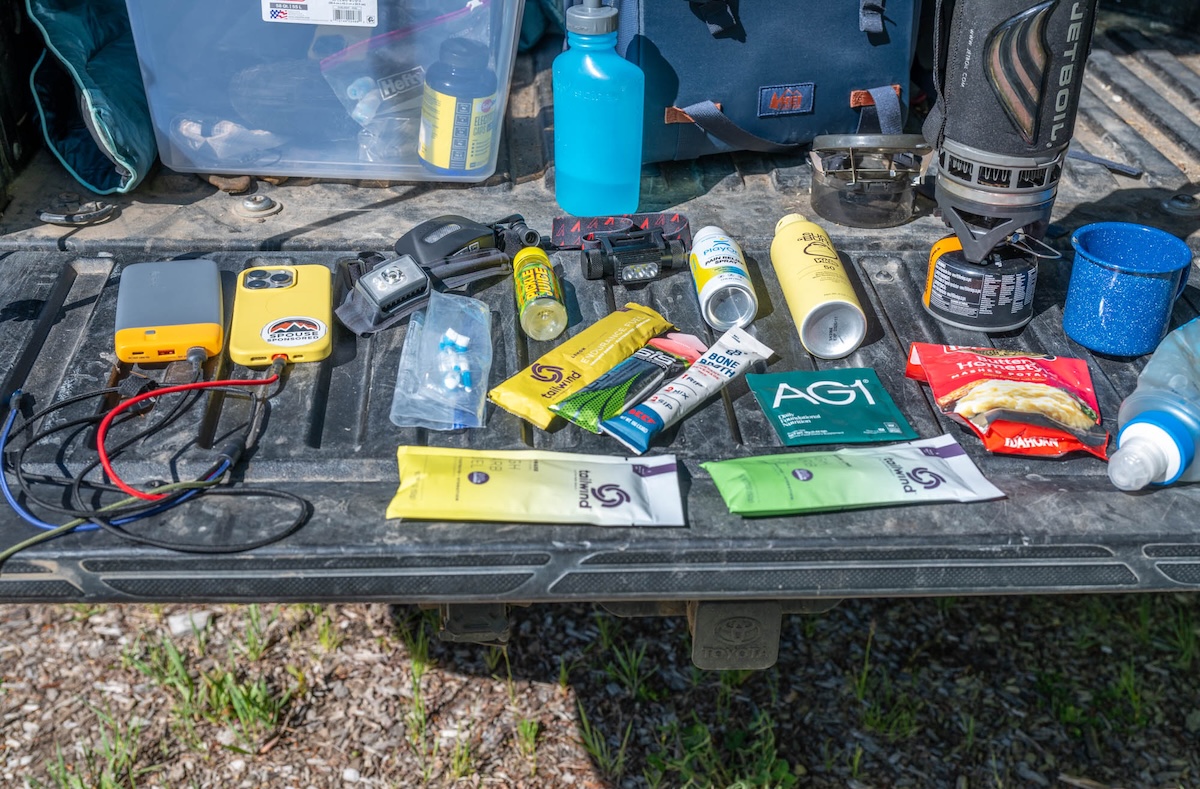 A portable stove (like a Jetboil) lets you make hot broth, soup, coffee, or instant potatoes—comfort food that can revive a fading runner.
A portable stove (like a Jetboil) lets you make hot broth, soup, coffee, or instant potatoes—comfort food that can revive a fading runner.
Pack their preferred fuel: Tailwind, gels, waffles, candy, whatever works for them. But also bring backups. Tastes change fast in ultras, especially after mile 50 and sometimes mile 10. Grocery stores are rarely convenient, so you’ll need to pack it all.
Add little comforts like toothbrushes, wipes, towels, and gum—tiny morale boosts that can freshen up a tough moment. Plus, mints and gum can reset the taste buds and be a nice change from the sweetness of gels.
Pro Tip: It’s easy to forget to take care of yourself in the hurry-up-and-wait game of crewing. Make sure to include snacks and hydration for yourself and your pacers.
Health & Recovery Tools
Your job isn’t just to cheer—it’s to help your runner reset their body at each stop.
Bring anti-chafing balm (Squirrel’s Nut Butter), plus sunscreen, SPF lip balm, and bug spray.
Add in cooling sprays or recovery balms to soothe hot or aching muscles. We discovered a new sports spray during John’s last 100-mile race called Play On Pain Relief Spray, which worked like a charm on his crampy calves.
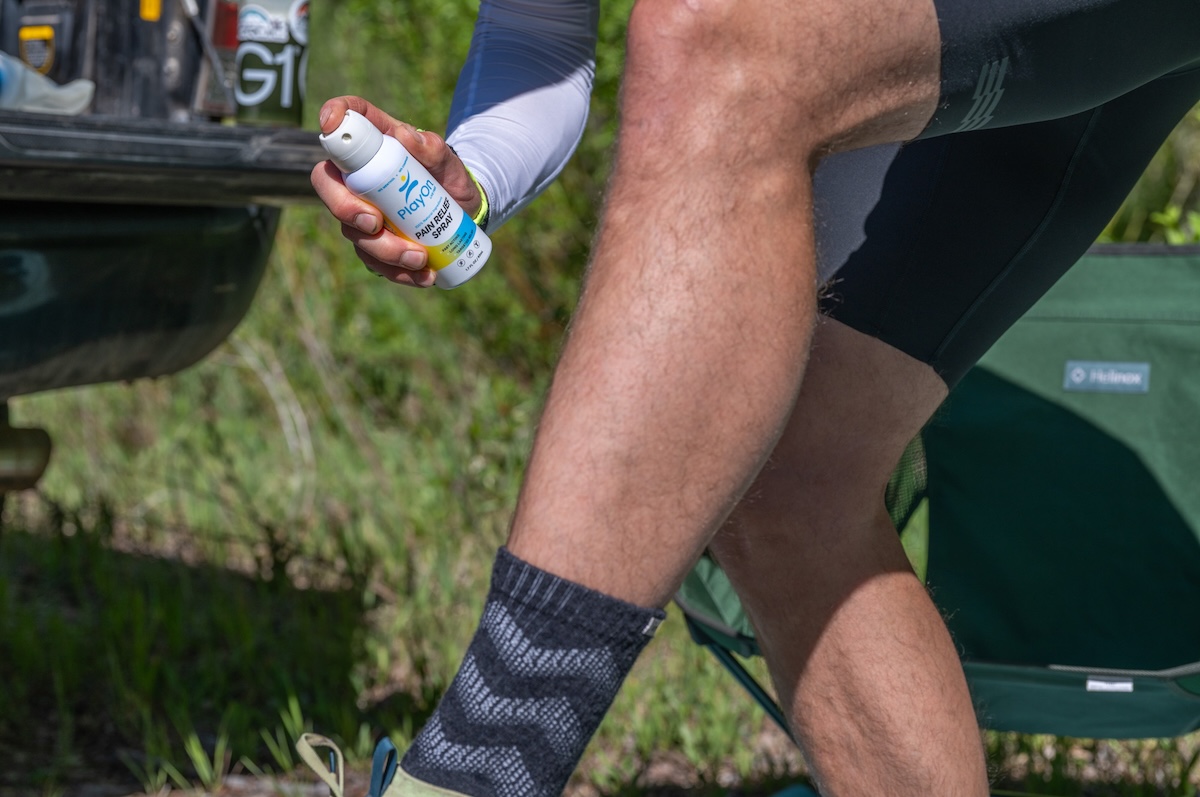 A massage device, such as the Theragun Mini or Hypervolt Go, or foam rollers/sticks can work wonders on stiff quads or locked-up calves.
A massage device, such as the Theragun Mini or Hypervolt Go, or foam rollers/sticks can work wonders on stiff quads or locked-up calves.
Most importantly, carry a complete first aid kit. Include blister kits, moleskin, tape, safety pins, salt tablets, preferred pain relief meds, Tums, ginger tabs, activated charcoal, and any other specific meds your runner might need. For menstruating runners, be sure to bring extra feminine products as well!
Clothing & Weather Gear
Ultras often involve extreme temperature swings, especially in alpine or high-desert terrain.
Pack cooling accessories for the heat (ice bandanas, sleeves, breathable hats) and lightweight, moisture-wicking shirts or sun hoodies. Mission offers a variety of cooling options that were instrumental in helping John finish a 50k in the desert with a heat advisory.
He was particularly grateful for the cooling power of the armbands, bandana, and brimmed hat. You just dunk them in water, and they stay cool for hours. We ended up packing them with ice for extra cooling power.
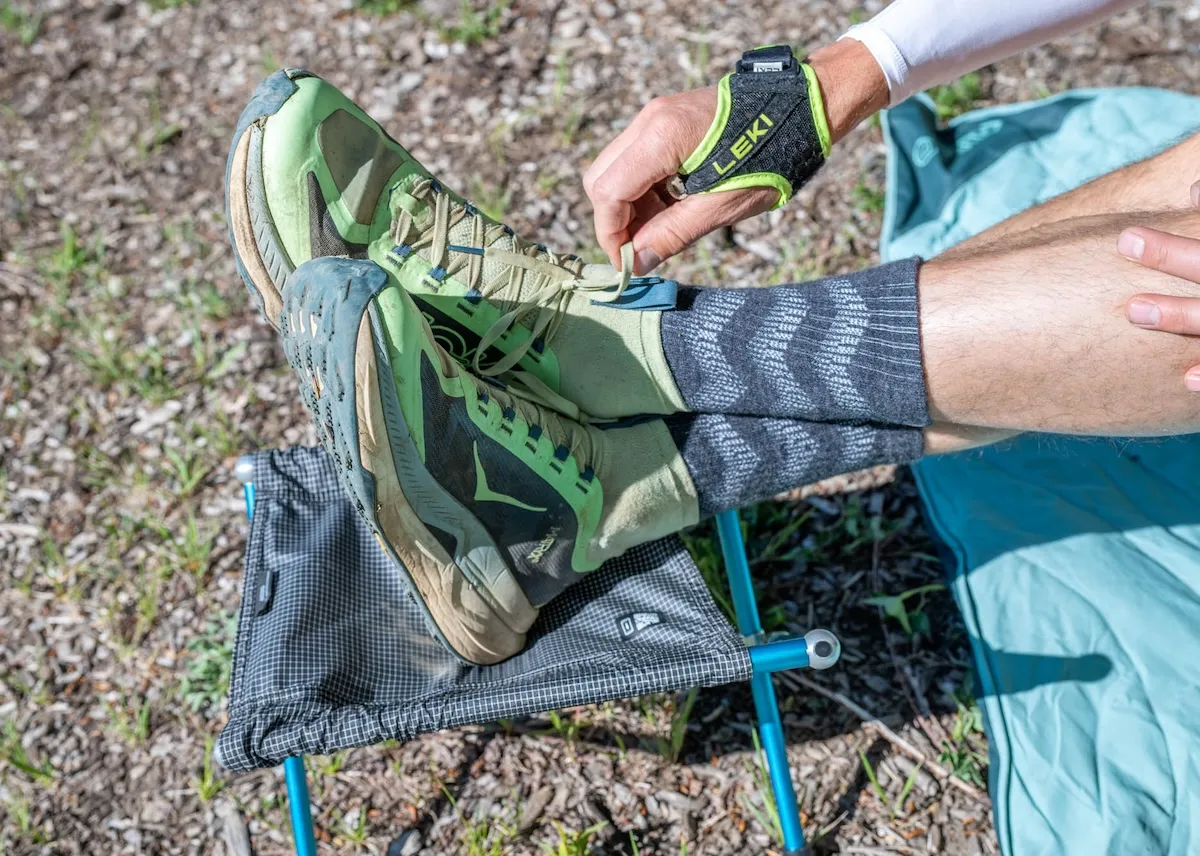 Bring multiple pairs of socks, gloves, buffs, and dry shoes—wet gear is one of the fastest ways to invite blisters and chafing. If you haven’t already tried Injinji toe socks, definitely check them out. They’ve helped us prevent countless blisters during both hot race days and muddy, wet conditions.
Bring multiple pairs of socks, gloves, buffs, and dry shoes—wet gear is one of the fastest ways to invite blisters and chafing. If you haven’t already tried Injinji toe socks, definitely check them out. They’ve helped us prevent countless blisters during both hot race days and muddy, wet conditions.
For cold weather, pack a puffy jacket, beanie, rain gear, and thermal layers. Don’t forget hand warmers and a pair of waterproof gloves—they’re small but make a big impact when the temperature drops. I always bring our Gorewear Concurve GTX jacket. It’s our go-to shell for wet weather: breathable enough to run in but tough enough to block wind and rain.
Layers are handy when the weather is inclement.
John prefers running in wool, which may sound counterintuitive, but Merino wool is incredibly effective at regulating temperature. For this year’s Hellbender 100, he wore the LeBent Nuyan Ultralight Hoodie from dusk to dawn. He crossed the finish line around 7 a.m., and the hoodie kept him warm enough overnight while wicking away sweat. It was the perfect layer for variable mountain temps.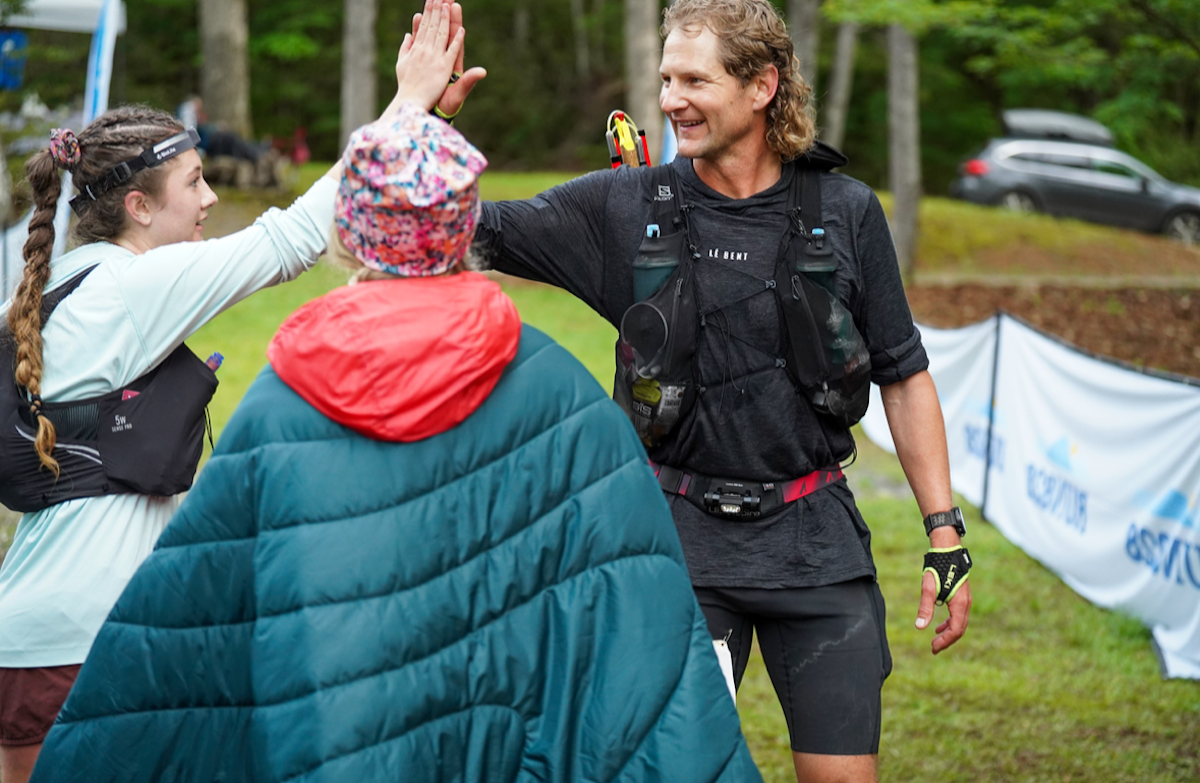 Sunglasses are another underrated essential. Whether it’s sun glare or cold wind, eye protection matters. I always pack a backup pair in case one gets left at an aid station. At Hellbender, John switched to the Adidas Dunamis Pro Sunglasses—he wore them for hours with his open-ear headphones and never once complained about discomfort.
Sunglasses are another underrated essential. Whether it’s sun glare or cold wind, eye protection matters. I always pack a backup pair in case one gets left at an aid station. At Hellbender, John switched to the Adidas Dunamis Pro Sunglasses—he wore them for hours with his open-ear headphones and never once complained about discomfort.
Weather can—and will—change fast. Pack like you’ll get sunburned and snowed on in the same day because it could happen!
Gear for Pacers
Don’t forget: Pacers are covering challenging terrain, too, often at night and for many miles.
Bring spare headlamps, batteries, socks, gloves, and backup nutrition just for them. If they’re waiting between pacing segments, give them a spot to rest, refuel, and change gear.
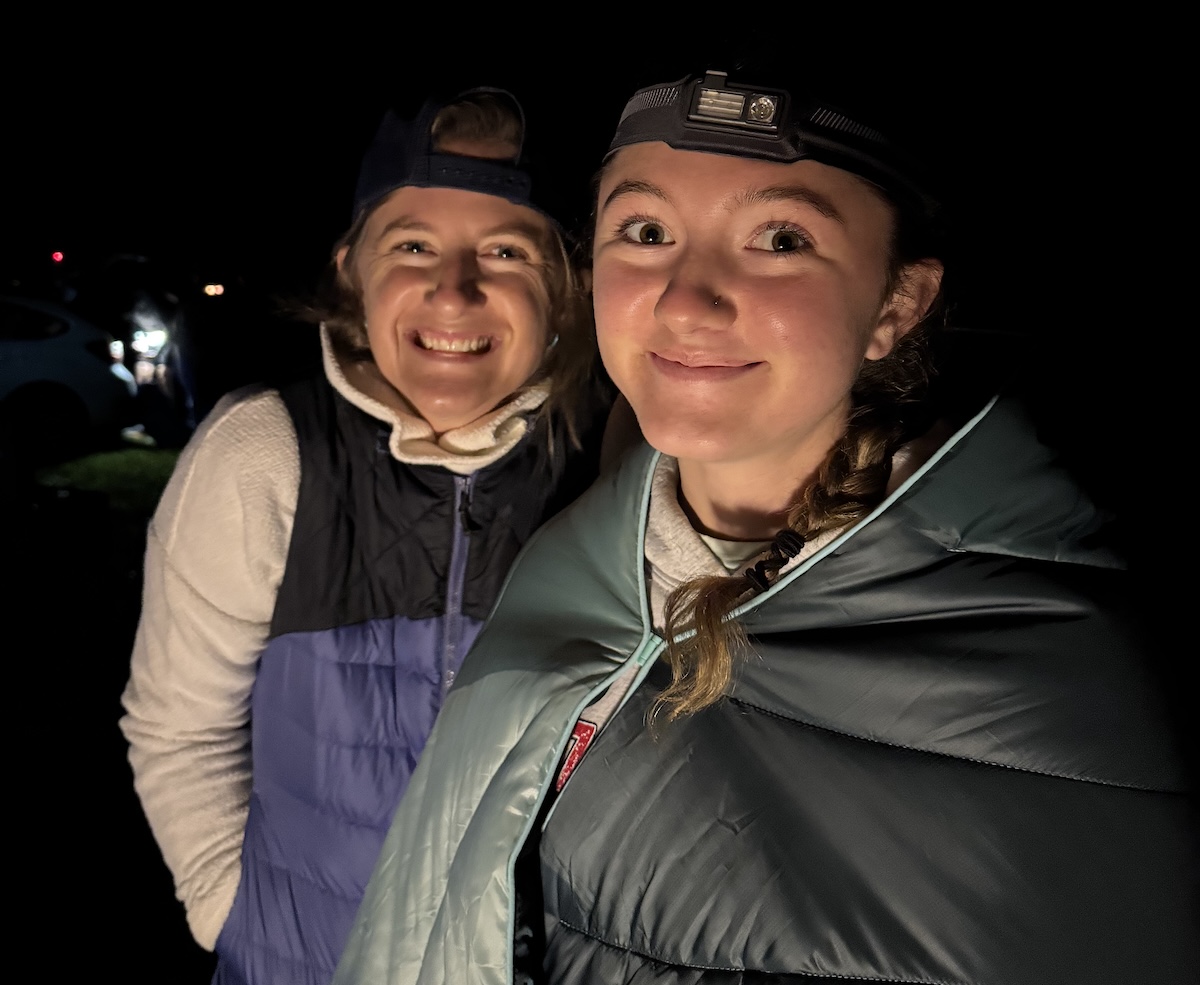 A well-cared-for pacer is an asset. A freezing, underfed one is going to slow down your runner.
A well-cared-for pacer is an asset. A freezing, underfed one is going to slow down your runner.
Bonus Gear That’s Surprisingly Useful
Some things aren’t must-haves, but these additional items can come in handy!
- Pop-up canopy or tent – Instant shelter from sun or storms
- String lights– Easy to spot your camp at night
- Sleeping bag or pad – For real rest at long aid stations
- Hanging shoe organizer – Mount it to your canopy for fast access to gear
- Sharpie + duct tape – Label everything, repair anything
- Ziploc bags – Great for pre-packed nutrition or storing wet gear
- Bluetooth Speaker – Who doesn’t love an impromptu dance party?! Just be mindful if you are away from the aid station and in a camping area.
- Books, games, and something to pass the time – You’ll likely have time between aid stations so bring something fun for you to do!
Final Thoughts
Crewing is hard work—but incredibly rewarding. The gear you pack helps create a calm, functional, reliable environment for your runner when everything else may feel uncertain.

The better prepared you are, the more adaptable you’ll be when plans inevitably change. Gear doesn’t guarantee a smooth day, but it gives you the tools to handle whatever the course throws your way—whether that’s hail at mile 60 or a meltdown at sunrise.
So pack with intention and prepare for anything because you never know what race day may bring!
What to read next? What to wear for a 100 mile race >>>>
BONUS THOUGHTS
Talk to Your Runner
Well before race day, have an honest conversation with your runner about how they want to be crewed. Every runner is different and knowing their preferences ahead of time will save stress later.
Ask these key questions:
- What kind of support do you want at aid stations?
- Fast and efficient? Calm and quiet? Do you want me to talk or just hand things over?
- How should I motivate you when things get hard?
- Tough love, encouragement, silence? What not to say if you’re struggling?
- What should I watch for?
- Missed calories? Signs of overheating or pain? Do you want reminders to eat, drink, or change gear?
- What’s in your drop bags—and what’s not?
- Be clear on where backup gear lives and what to do if plans go sideways.
Pro tip: Jot down their answers into a simple crew cheat sheet. A few notes now can save a meltdown at mile 75.
Know the Course Type
One of the first things to consider is the format of the race:
- Looped Course: Your runner returns to the same aid station multiple times. You’ll typically set up in one spot, settle in, and wait. Comfort and a well-organized basecamp are key.
- Point-to-Point / Out-and-Back Course: You’ll need to drive (and sometimes hike) to reach different aid stations throughout the course. This adds complexity to timing, navigation, and gear organization.
How the course is structured will shape almost everything about your crewing strategy, so always start there.
Smart Planning
Start with the race rules (this is worth repeating!!) Seriously—read them. Know where you’re allowed to crew, any time restrictions, and the parking situations at each aid station. I often print the rules and maps and carry them with me. It’s not worth risking a disqualification over an honest mistake, like crewing in an off-limits area.
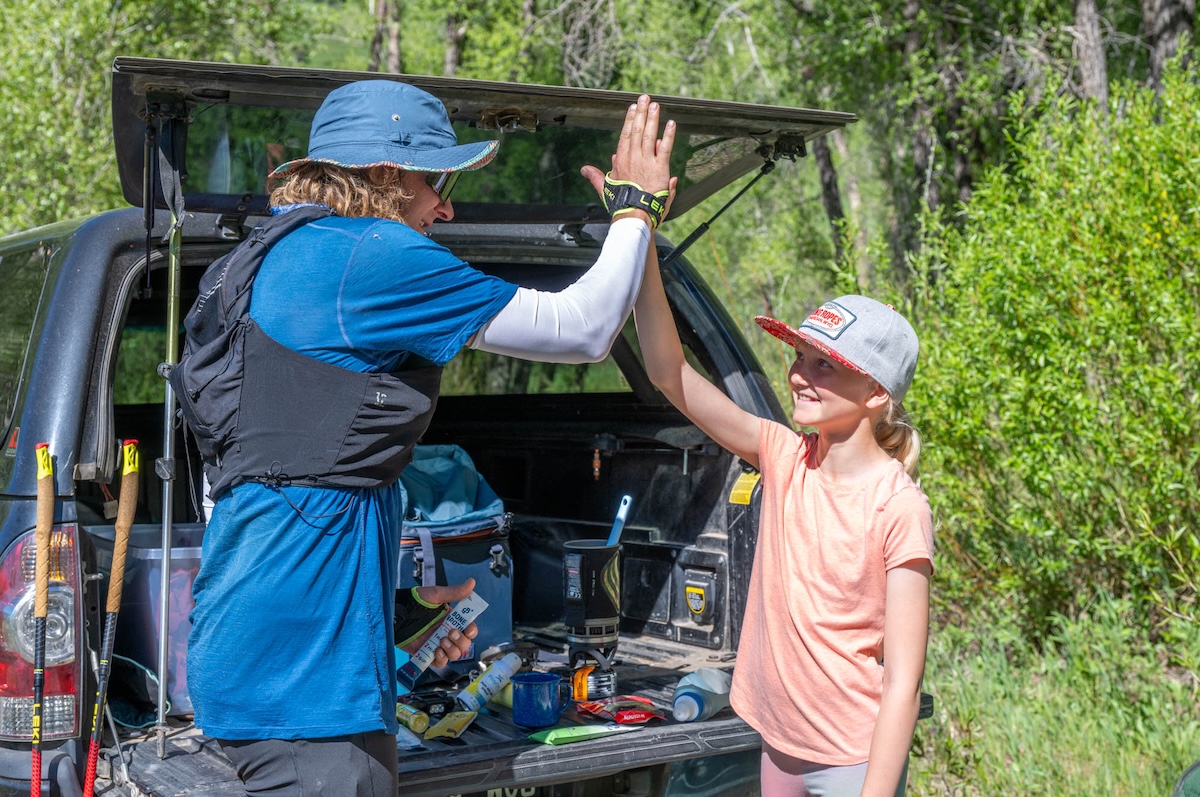 Next stop: Ultrapacer.com. This free tool is a lifesaver. Plug in your race and an estimated finish time, and it calculates your runner’s projected arrival at each aid station, factoring in elevation and terrain. It’s not perfect (no tool is), but it gives you a solid timeline to plan meals, naps, and logistics.
Next stop: Ultrapacer.com. This free tool is a lifesaver. Plug in your race and an estimated finish time, and it calculates your runner’s projected arrival at each aid station, factoring in elevation and terrain. It’s not perfect (no tool is), but it gives you a solid timeline to plan meals, naps, and logistics.
Pro tip: Share the Ultrapacer plan with your entire crew. When everyone’s on the same page, you avoid chaos. If possible, assign someone to handle race updates for family and friends. Communication can be hard in the moment, and offloading that job frees you up to focus on your runner.
The Mental Side of Crewing
Crewing an ultra is more than logistics—it’s emotional work. You’ll get tired, cold, and maybe go 40 hours without changing your clothes. Stay steady and remember your role:
- It’s not about you. You’re the support system. Be flexible, calm, and encouraging.
- Stay grounded. Runners may cry, puke, or say they’re quitting. You don’t need to fix it—just be present.
- Be the voice of reason. Remind them they trained for this. A simple “You’re OK. You are looking strong” can work wonders.
- Don’t take it personally. Tired runners can snap. It’s not about you.
- Take care of yourself. Eat, hydrate, rest if you can. A clear-headed crew is a good crew.
In the End…
Crewing is emotional, chaotic, and deeply rewarding. You’ll make soup in the rain, cry with strangers, witness grit like you’ve never seen, and play a critical role in helping someone finish one of the toughest challenges of their life.
So pack smart. Stay flexible. Be ready for everything. And have FUN!



 Run Under the Stars: Nighttime Races You’ve Never Heard Of (But Should!)
Run Under the Stars: Nighttime Races You’ve Never Heard Of (But Should!)
